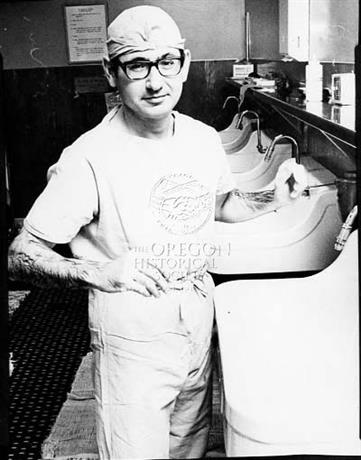Miles Lowell Edwards was born in 1898 in Newberg, a town his grandfather Jesse Edwards had established in 1880 as a Quaker community. His father, Clarence Edwards, started the first electricity-generating business in town, and Lowell grew up climbing poles to repair his father’s power lines. As an adolescent, he spent weeks in bed recovering from rheumatic fever. Fifty years later, one of his inventions would provide hope to patients who suffered lethal heart valve damage as a consequence of that disease.
Edwards was studious and skillful, and in 1924 he graduated from Oregon Agricultural College (now Oregon State University) with a degree in electrical engineering. He won a competition sponsored by General Electric Research Laboratory in Schenectady, New York, and was appointed as an engineering apprentice. GE’s business leaders wanted practical inventions, and for three years Edwards honed his skills as an inventor. Returning to Oregon in 1927, he married Margaret Watt.
In the early 1930s, Edwards was named chief engineer at Bingham Pump Company in Portland, where he designed industrial pumps. In 1937, he accepted a position as plant engineer at Weyerhaeuser Timber Company’s pulp mill in Longview, Washington. There he designed a powerful water pump, which generated a jet of water capable of ripping bark from logs. The hydraulic tree de-barker was his first major invention.
Before long, Edwards became fascinated by centrifugal pumps, and he began building prototypes in his home workshop. His “trick” pump was a flat plate with flanges, which spun inside a chamber and forced the fluid outward into pipe. In 1940, engineers at Boeing Aircraft in Seattle were desperate to find a fuel pump that could reliably deliver gasoline to aircraft engines. Boeing’s new B-17 bomber was required to fly at high altitudes, but conventional fuel pumps failed because the volatile fuel formed gas bubbles that blocked the flow at low atmospheric pressure. Edwards’s centrifugal spinning pump separated the fluid phase from the vapor bubbles and it was used in the majority of American military aircraft for the next decade.
When Edwards retired in 1947, he and Margaret bought a home in Portland and he began pursuing a new area of investigation. Reasoning that the heart was simply a pump, he designed a prosthetic heart to replace a failing human heart. In the spring of 1958, he met with Albert Starr, a heart surgeon at the University of Oregon Medical School, and proposed collaborating on studies of his new invention. Starr persuaded Edwards to focus instead on a prosthetic heart valve, and over the next two years he manufactured a series of valves for Starr to test.
On September 21, 1960, Starr successfully inserted a “ball-in-cage” prosthetic valve into a patient’s mitral valve, which was severely diseased because of rheumatic fever. Within two years, Edwards and Starr had invented a life-saving aortic valve prosthesis, which would save the lives of several hundred thousand patients around the world. In April 1961, Edwards became an early pioneer in the biomedical high-tech field when he founded Edwards Laboratories in Santa Ana, California, to manufacture high-quality valve prostheses.
Lowell Edwards was skillful, curious, and had a capacity to focus on building practicable prototypes. A modest man who shunned publicity, he held over sixty patents and was a generous philanthropist. He received the American Medical Association’s Layman's Citation for Distinguished Service in 1963. Edwards died in 1982; he and Margaret are buried in the Friends Cemetery in Newberg.
-
![M. Lowell Edwards in home-built Model T Ford, 1920.]()
Edwards, Miles Lowell, in Model T, 1920.
M. Lowell Edwards in home-built Model T Ford, 1920. Oreg. State Univ. Archives, Coll. of Eng. Photo Collec., P069
Related Entries
-
![Albert Starr (1926-2024)]()
Albert Starr (1926-2024)
Albert Starr was a boldly innovative surgeon whose precisely choreograp…
-
![Newberg]()
Newberg
Newberg, the second largest city in Yamhill County, is located about a …
Map This on the Oregon History WayFinder
The Oregon History Wayfinder is an interactive map that identifies significant places, people, and events in Oregon history.
Further Reading
Edwards, Margaret. Miles Lowell Edwards: His Ancestors and Descendents. Santa Ana, Calif.: Pioneer Press, 1972.
Edwards, Miles J. Interview by Annette Matthews, Aug. 7, 1998. Oregon Health & Science University Oral History Project, Oregon Health & Science University Library, Historical Collections & Archives, Portland, Ore. http://www.ohsu.edu/xd/education/library/about/collections/historical-collections-archives/oral-history-program/index.cfm.
Jelsing, Nadine. "How 2 Oregonians invented the world's first successful artificial valve." Oregon Experience. Oregon Public Broadcasting, December 13, 2023.



